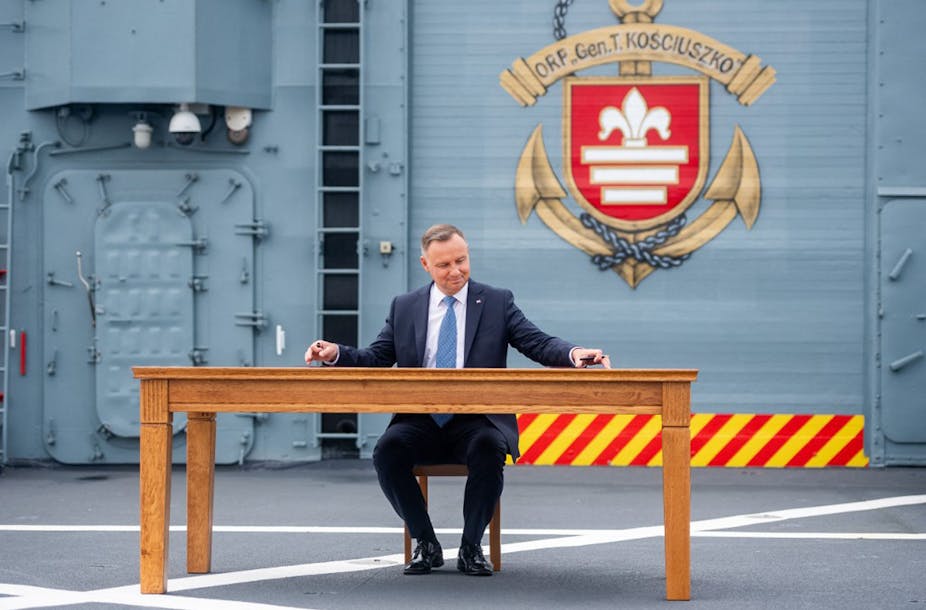By supporting Ukraine at a time of need, the Polish government has chalked up points with other European governments. Soon after Russia invaded, in late February, Poland welcomed hundreds of thousands of refugees and drummed up support for arming Kyiv. In March, it sent its prime minister to Kiev alongside Czech and Slovenian counterparts. Three months later, Germany, France and Italy were playing catch-up, bolstering the ruling Law and Justice (PiS) party narrative that European leadership was shifting to the East. Warsaw’s harder stance on Russia also increasingly appears vindicated, as the conflict sheds light on the security issues of NATO’s eastern flank.
But Russia’s war against Ukraine has also spurred less liberal ambitions. The Polish Defence Minister has repeatedly trumpeted its plans to more than double its security budget in 2023 with the view to building up a “great army” capable of withstanding the shock of a Russian armed attack.
Europe’s most powerful army
Analysts believe such plans could make the Polish army the most powerful in Europe. French defence website Méta Défense highlights a “spectacular reinforcement of the Polish army’s overall capacity, which, by the end of the decade, will include 1,500 modern tanks, an equal number of infantry combat vehicles, 1,200 mobile artillery units and several thousand light armoured vehicles to exceed the arms capacity of the French, German, UK, Italian, Dutch and Belgian forces combined”.
The government, which is expected to spend 3% of the national budget on defence, now intends to grow its land army from four to six divisions, equivalent to 300,000 soldiers, compared with the current figure of 115,000. It will also see a significant boost in firepower. The national defence policy excludes pre-emptive strikes but seeks to deter any armed aggression.
Warsaw will rely not only on purchasing existing technology, but also on partnerships that are likely to strengthen the Polish national arms industry. Plans have been made to acquire US tanks and helicopters, as well as HIMARS missiles, the latter of which proved highly effective during combat in Ukraine.
Other contracts have been signed with South Korea, including shipments of tanks and howitzers and as recent orders of 288 artillery rocket launchers. More importantly, these purchases from Seoul appear to include technology transfers and cooperation deals that could increase the autonomy of the Polish defence industry, perhaps even to rival that of the country’s western European counterparts.
All along, the EU’s defence industries have been systematically disregarded in favour of US, UK and South Korean equipment (with Poland switching from Airbus to Italian brand Leonardo, only to drop them for Boeing Apache helicopters).
The PiS favours overseas kit
These plans chime with the realist “geopolitical ideology” driving PiS and large swaths of the Polish conservative landscape. They also clarify the country’s position on Europe.
Ever since the early 1990, the Polish right wing has considered NATO membership more significant than EU membership, whereas liberals and moderates have been more open to the political integration of Europe. These discrepancies have long beenblurred by Poland’s more general concern to be part of the international organisations of Europe and the western world, but they are now becoming more and more salient.
For the PiS, the EU appears as a secondary arena, particularly given the bloc’s readiness to confront Poland when it considers its government violates certain European principles. The new arms deals with South Korea are a clear indication the PiS government no longer wishes to depend upon, or show internal solidarity with, the EU in matters of defence.

These developments may be linked to attempts that were made back in January to create a new alliance with Ukraine and the UK. It is evident PiS sees the EU simply as a stepping stone on the path toward liberal globalisation, rather than a means of integration and new solidarity between member states.
Full-on rearmament
News of the military expansion have come under fire from the Polish opposition. Opposition parties unanimously supported a move that allocates 3% of the national budget to defence, but Jarosław Kaczyński, the PiS President and effective leader of the government wants it to reach 5% in the future.
Some former defence ministers have said the current approach will damage local industry. A scandal involving French-made Caracal helicopters, dating back to 2016, has also resurfaced, following a leak of old government e-mails that plotted a smear campaign against the French equipment. These Airbus helicopters were due to be delivered to Poland between 2017 and 2022, whereas 96 new US Apaches have just been commissioned, with only 18 deliveries confirmed so far. All this has occurred outside the usual bidding procedure.
Opposition leaders also denounce PiS’s anti-Europeanism, revealing cracks within what was once a pro-Atlantic consensus. Opposition parties have pledged to review the government’s military contracts should they emerge victorious from elections in 2023.
Could the plans be scrapped?
The current rearmament policy is being rolled out ahead of an election that, according to polls, looks less positive for the PiS. The country has seen the highest inflation (at almost 16.4%) since the 1990s. Various other crises that have been mismanaged by the government, including the Oder environmental disaster.
Rocketing household energy prices and coal shortages are liable to hurt the groups likeliest to vote for PiS (e.g. elderly people, rural areas and regions of economic stagnation), who may turn out in fewer numbers during the legislative election.
In light of this difficult situation, the PiS is pushing its defence position and nationalist rhetoric to reinvigorate rifts and polarise politics, especially by playing an anti-German card. The PiS has even managed to bring the issue of German reparations back to the fore, for the devastation caused to Poland in WWII. But these all-too-obvious electoral gimmicks may not work as well as they did in the past.
Translated from the French by Enda Boorman for Fast ForWord


